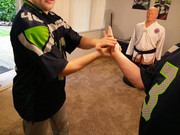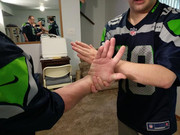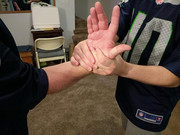skribs
Grandmaster
Take 2 of my "wrist lock names" thread. Like I said before, in my school we number them. But humans work better with names than numbers. So it would be easier to have names. This time, instead of relying on descriptions, I'll be posting pictures!
Please note that I'm going for the names of the techniques, and not the critiques on them. We didn't go hard on the techniques for the photos, just enough to get the idea of what we're doing.
(Also, if you can, guess what we watched on TV before taking pictures, and what we're going to watch on TV after).
And again, if you can guess what we watched before taking these pictures, or what we are going to watch next, go ahead and try.
Please note that I'm going for the names of the techniques, and not the critiques on them. We didn't go hard on the techniques for the photos, just enough to get the idea of what we're doing.
(Also, if you can, guess what we watched on TV before taking pictures, and what we're going to watch on TV after).


I believe this is a "Z-Lock." The idea is in the first picture to hold their wrist and click their hand up, and in the second picture to trap their hand and push their wrist down. Both accomplish virtually the same thing.







I believe this is a V-Lock. I am showing here 3 different ways this can be done, by pulling on the hand, by pushing on the knuckles, and by twisting the hand.

I believe this is a Figure-4. Might be kind of hard to see what we're doing here, but I've heard it plenty of times.

At this point, I'm out of names. This one works similar to a Figure-4 by using the tilt of the shoulder to get them off balance. But instead of getting their arm out and back, this gets their elbow up and back.

This is kind of a bad image, and probably doesn't look much like a wrist lock. We do get the goose-neck when we can. We'd swing our outside leg back to use this as a throw or take-down.

From here you can either keep backward pressure on the wrist and push the hand to push them away, or you can use forward pressure on the hand and pull on the wrist to pull them towards you. (A lot of our techniques go back and forth).

Similar to #6, this is an armbar using the wrist to create tension along the arm. Pressure on the hand can cause a lot of pain up the arm.




The opposite of #7, locks designed to simulate the pain of Carpal Tunnel.


Using pressure on the elbow to lift someone up and get them off-balance.
And again, if you can guess what we watched before taking these pictures, or what we are going to watch next, go ahead and try.
